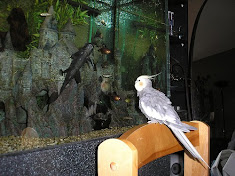Many people are enthralled by the idea of having sharks in their aquarium. Admittedly, the very word shark imparts a certain aura of magic and power, that the desire to have one is understandable. It should, however, be noted that what are commercialized as aquarium sharks in pet stores are in fact species of freshwater catfish and minnows.
If you have your heart set on a genuine shark for your aquarium, unfortunately they simply are not available to the home aquarium enthusiast. These fish that are labeled aquarium sharks are, however, ideal substitutes. All have a body structure that is similar to that of a real shark, dorsal fin and all.
Below are some of the most common species of aquarium sharks:
Bala Sharks
Also known as silver sharks due to their coloration, this species will grow to a length of eight inches, but some individual specimens can reach lengths of up to twelve inches. They display schooling behavior when kept in groups of their own species. They can be considered to have a docile personality with regards to other fish, even those smaller than them. Due to their schooling instincts, the bala shark will be more at ease when grouped with more of its own species.
The drawback of the bala shark is its size. This requires a tank that is at least 48 inches long. Also, they are notorious jumpers. Aquariums with bala sharks should be securely covered to prevent them from jumping out of the water.
Rainbow Sharks
This species of aquarium shark is more colorful than the bala shark, sporting reddish tails and fins. They, however, are quite aggressive with other fish and amongst themselves. It is best to keep them in a single species aquarium and, unless you can house more than six at a time, an individual specimen is best. This is due to their quest for dominance amongst themselves. If you have two or three, there will be bitter confrontations to establish a dominant fish. If, however, you have six or more present, the quest for dominance is curtailed in that there are too many in a defined space for one to emerge victorious.
Rainbow sharks can grow to be nine inches in length, again making a 48-inch tank or larger a necessity.
Blue Torpedo Shark
This is a species closely related to the catfish. They can grow to be 14 to 16 inches long and require a lot of space. 60 to 72-inch tanks are normally called for to properly house this species. Their size and somewhat aggressive behavior do not make them a good addition to a multi-species tank. For the most part they would be best in single specimen tanks.
As you can see, size becomes an issue with these aquarium sharks. This excludes them from consideration for those aquarium enthusiasts who have tanks smaller than 48-inches. With the exception of the bala shark, aggressiveness and temperament also play a role. For the most part these would have to be placed in single species or even single specimen aquariums.
For those that do decide to get an aquarium shark, it is important to feed your shark a combination of brine shrimp, blood worms and commercially prepared food and not to succumb to the urge of feeding them live food. This will go a long way in curtailing aggressive behavior and also keeping the tank clean. Most of these aquarium sharks do not eat their live food whole. Rather, the food may be eaten in pieces which results in carcass debris to be widely scattered and the risk of water contamination greatly increased.
Aquarium sharks are very beautiful and majestic; they just may not be for everybody that wants them.
About the Author: Written by Andrew Stewart
If you want to learn more about Aquarium Sharks, you can visit my website at http://www.learnfreshwateraquariums.com for helpful tips on setting up, maintaining and caring for both your Freshwater Aquarium and the fish that inhabit it.
Source: www.isnare.com
Permanent Link: http://www.isnare.com/?aid=698740&ca=Pets
Photo Credits
Bala Shark by Jeff Cushner
Rainbow Shark by Drachenschwertträger36
Blue Torpedo Shark by fishtankforum_2009
Subscribe to:
Post Comments (Atom)




0 comments:
Post a Comment